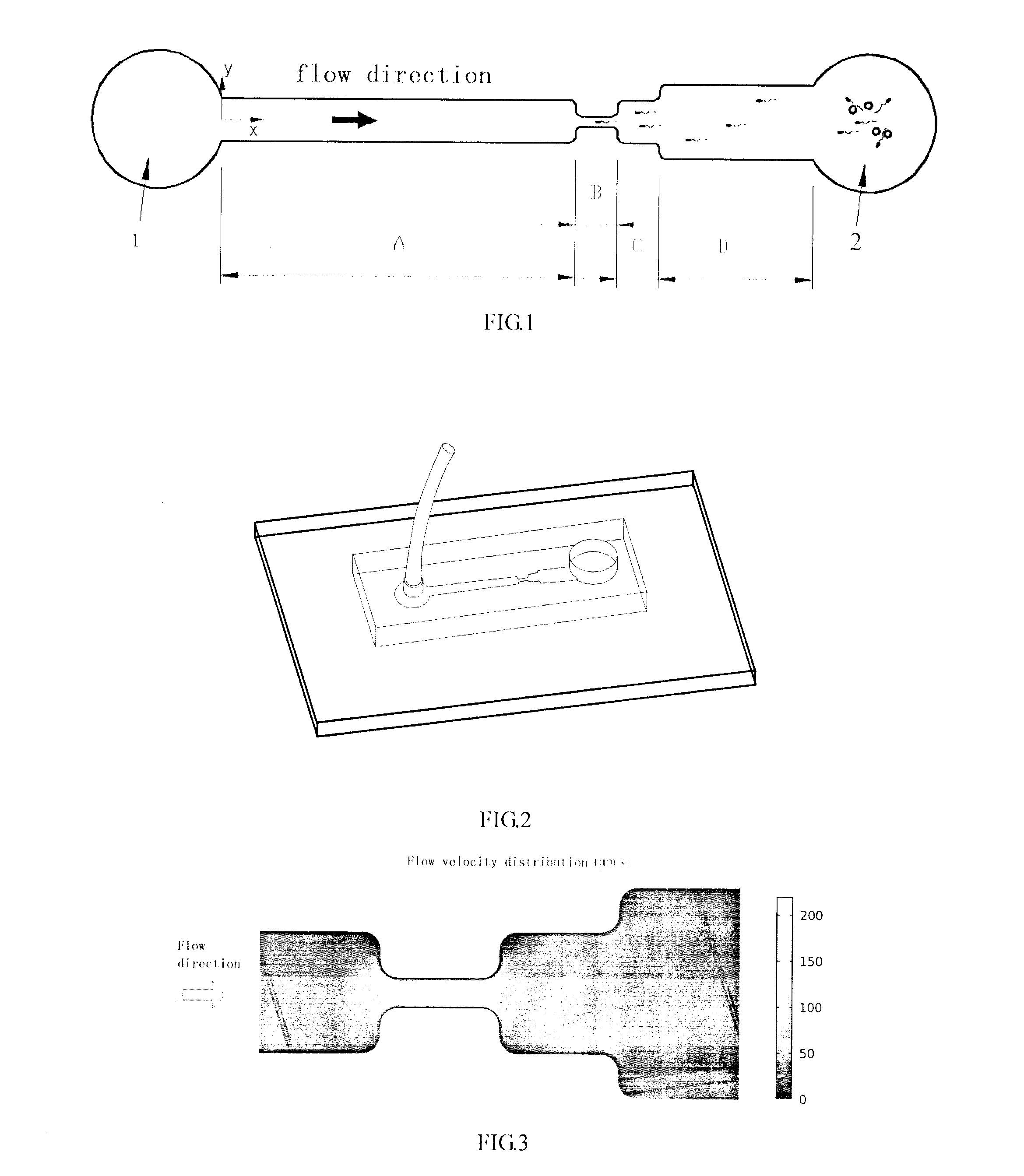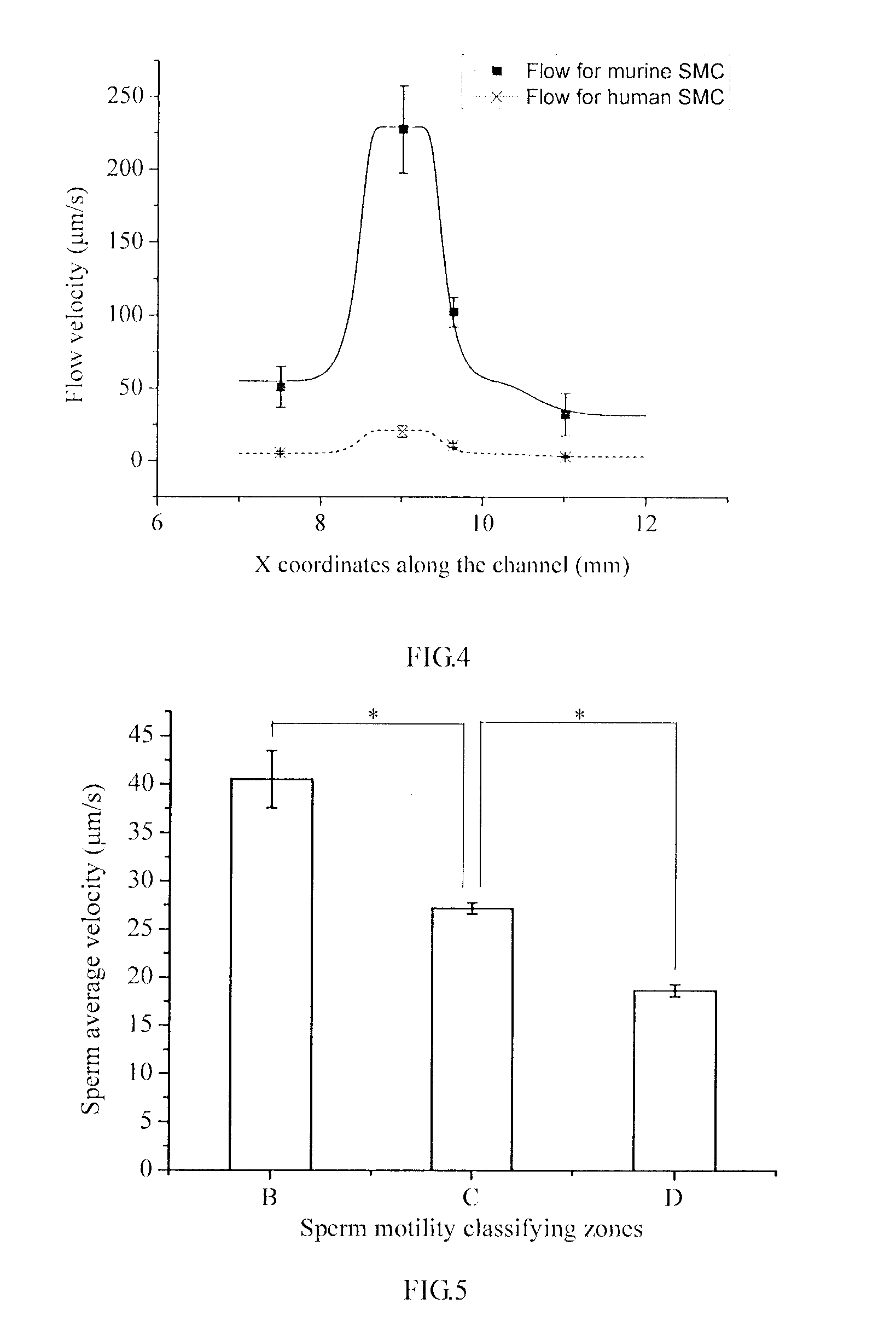Method for sperm motility evaluation and screening and its microfluidic device
a microfluidic device and sperm technology, applied in the field of microfluidic devices, can solve the problems of complex structure and operation of the chip, inability to screen and separate sperm in specific velocity range for subsequent in vitro fertilization (ivf) or research, and the existing microscopic observation method cannot be used in the evaluation of sperm, etc., to achieve the effect of measuring detecting the motility of cells
- Summary
- Abstract
- Description
- Claims
- Application Information
AI Technical Summary
Benefits of technology
Problems solved by technology
Method used
Image
Examples
example 1
Microfluidic Device
[0062]Referring to FIG. 1, one embodiment of the microfluidic chip consists of a micro-channel with rectangular cross-sections, which is connected with fluid inlet 1 and sample inlet 2. The channel consists of 4 sections, namely sections A, B, C and D, with the same height of 25 μm and the widths of 1, 0.24, 1 and 1.74 mm, respectively. The channel width of sections B, C and D increases, while the ratio of their widths is set by reference to the sperm motility classification (SMC) criteria released by World Health Organization (WHO). The cross-sections of the channel in the present invention are rectangular, and the cross-sectional area is the product of the width and the height, so the cross-sectional areas increase. Because of Bernoulli's principle for incompressible flows, the velocity of the fluid decreases when the cross-sectional area of the channel increases.
[0063]In the present embodiment, the cross-sectional areas of section B, C and D increase successive...
example 2
Integrated Mouse Sperm Motility Screening and Chemotaxis Assay
[0068]Sperm Motility Classification
[0069]The method to use the microfluidic chip as illustrated in FIG. 1 in the present embodiment is as follows: cell culture medium (or working solution) was influxed with certain flow rate from fluid inlet 1 by constant positive pressure from an injection pump, which resulted in a flow field with stable but different flow rates in sections A, B, C and D. The flow field was stabilized after 10 minutes, then 3 human semen sample (or 3 μL murine sperm solution) was pipetted into sperm inlet 2. Sperms swam against the flow and were trapped in the regions where a sperm's velocity equaled the local fluid flow velocity, resulting in that the combined velocity was zero. Thus, the motility of sperms trapped in sections B, C and D decreased in order, and the sperms with low motility as well as cells in semen that did not swim by themselves, e.g., spermatogonial cells, epithelial cells, white bloo...
example 3
Retrieve or Research on the Sperm with Specific Velocity
[0072]When retrieving sperms with specific velocity, the culture medium influxed from fluid inlet is stopped. Sperms keep swimming spontaneously and arrive at the fluid inlet 1. Because sperms with different velocities are captured in section B, C and D, and the fastest sperms are the closest to the fluid inlet 1, sperms arrive at the fluid inlet 1 in order according to their velocities. This facilitates the recovery of sperms after motility classification.
[0073]The sperm can also be retrieved by the following methods: 1) apply a negative pressure at the fluid inlet 1, in order to transport sperm with different velocity captured in section B, C and D to the fluid inlet 1. The distances between the three sections and the fluid inlet 1 are different, so that sperms in various sections will arrive at different time; 2) a series of micro-electrodes are arranged along the bottom of the channel, and sperms with different velocities a...
PUM
| Property | Measurement | Unit |
|---|---|---|
| velocity | aaaaa | aaaaa |
| size | aaaaa | aaaaa |
| height | aaaaa | aaaaa |
Abstract
Description
Claims
Application Information
 Login to View More
Login to View More - R&D
- Intellectual Property
- Life Sciences
- Materials
- Tech Scout
- Unparalleled Data Quality
- Higher Quality Content
- 60% Fewer Hallucinations
Browse by: Latest US Patents, China's latest patents, Technical Efficacy Thesaurus, Application Domain, Technology Topic, Popular Technical Reports.
© 2025 PatSnap. All rights reserved.Legal|Privacy policy|Modern Slavery Act Transparency Statement|Sitemap|About US| Contact US: help@patsnap.com



